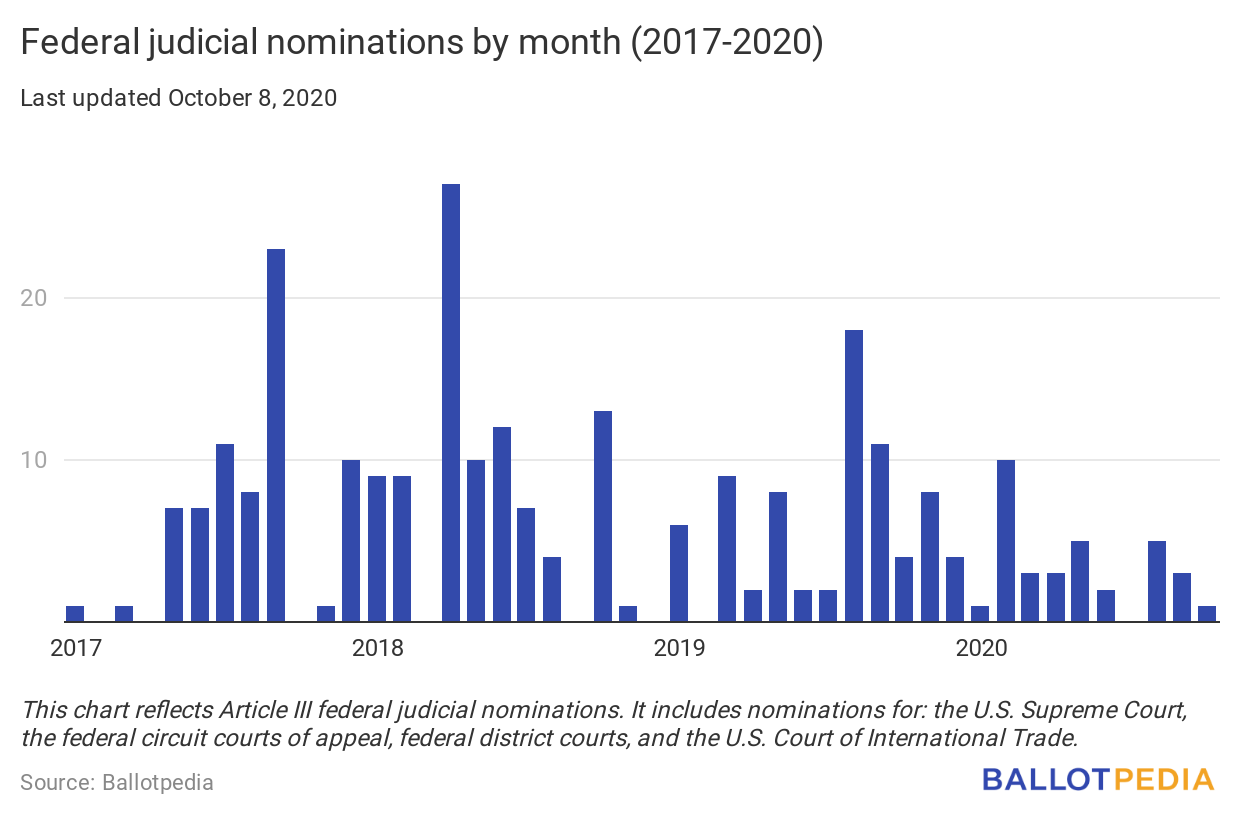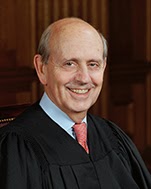| Welcome to the October 12 edition of Bold Justice, Ballotpedia’s newsletter about the Supreme Court of the United States (SCOTUS) and other judicial happenings around the U.S. SCOTUS began its new term last week. Keep up with the latest court news by following us on Twitter or subscribing to the Daily Brew. |

Arguments
The Supreme Court will hear four hours of arguments this week via teleconference with live audio. The court made the decision to hold proceedings this way in accordance with public health guidance in response to COVID-19.
SCOTUS has agreed to hear 35 cases during its 2020-2021 term. Of those, 12 were originally scheduled for the 2019-2020 term but were delayed due to the coronavirus pandemic. Click here to read more about SCOTUS’ current term.
In its October 2019 term, SCOTUS heard arguments in 61 cases. Click here to read more about SCOTUS’ previous term.
Click the links below to read more about the specific cases SCOTUS will hear this week:
- October 13
- United States v. Briggs is consolidated with United States v. Collins. In United States v. Briggs, a general court-martial convicted Michael Briggs of rape in 2014 for an act that occurred in 2005. Briggs appealed the conviction to the U.S. Air Force Court of Criminal Appeals, asserting the statute of limitations had expired. The Air Force Court of Criminal Appeals rejected Briggs’ statute of limitations assertion and affirmed the court-martial’s decision.
Briggs appealed to the U.S Court of Appeals for the Armed Forces, which affirmed in part the Air Force Court of Appeals’ ruling. Briggs also appealed to the U.S. Supreme Court, which vacated the U.S. Court of Appeals for the Armed Forces’ decision and remanded the case. On remand, the Court of Appeals for the Armed Forces reversed its earlier judgment, dismissed the charge against Briggs, and vacated the sentence. The U.S. government appealed to the U.S. Supreme Court.
The issue: Whether the Court of Appeals for the Armed Forces was wrong to conclude, against its own precedent, that the Uniform Code of Military Justice allows prosecution of a rape that occurred between 1986 and 2006 only if the rape was discovered and charged within five years.
- In City of Chicago, Illinois v. Fulton, the City of Chicago towed and impounded Robbin Fulton’s vehicle in 2017. Fulton filed a petition for Chapter 13 bankruptcy and a repayment plan in federal bankruptcy court. Fulton requested that the City return her vehicle. The City declined to do so. Then, Fulton moved for sanctions against the City of Chicago, arguing it was required to return her vehicle. The City asserted that it would retain possession of the vehicle and cited an exemption from the Bankruptcy Code’s automatic stay.
The bankruptcy court ruled that the City was required to return the vehicle. The City moved to stay the order, but the court denied the request. The City returned the vehicle and appealed to the 7th Circuit. The court affirmed the bankruptcy court’s ruling.
The issue: Whether an entity that is retaining possession of property in which a bankruptcy estate has an interest is obligated under the Bankruptcy Code’s automatic stay, 11 U.S.C § 362, to return the property immediately upon the filing of a bankruptcy petition.
- October 14
- In Torres v. Madrid, New Mexico State Police Officers Richard Williamson and Janice Madrid attempted to serve an arrest warrant on Kayenta Jackson at an Albuquerque apartment complex in 2014. Roxanne Torres was in the complex parking lot. When the officers approached her vehicle, Torres entered her vehicle, thinking the officers were carjackers, and drove the car forward. The officers shot her twice.
Torres drove from the scene and was treated at a hospital for her injuries. She was arrested and pleaded no contest to three crimes related to the event. In 2016, Torres sued the officers in U.S. District Court claiming excessive force. The district court interpreted the complaint as asserting excessive force claims under the Fourth Amendment. The court ruled that the officers were entitled to qualified immunity and that since the officers had not seized Torres at the time of the shooting, they had not violated the Fourth Amendment. The U.S. Court of Appeals for the 10th Circuit affirmed the district court’s ruling. Torres filed an appeal with the Supreme Court.
The issue: “Is an unsuccessful attempt to detain a suspect by use of physical force a ‘seizure’ within the meaning of the Fourth Amendment, as the Eighth, Ninth, and Eleventh Circuits and the New Mexico Supreme Court hold, or must physical force be successful in detaining a suspect to constitute a ‘seizure,’ as the Tenth Circuit and the D.C. Court of Appeals hold?”
- In Pereida v. Barr, Clemente Avelino Pereida, a citizen and native of Mexico, was convicted of attempted criminal impersonation in Nebraska. The U.S. Department of Homeland Security charged Pereida with removal from the country (also known as removability). Pereida filed an application for relief from removal. An immigration judge found that his conviction was a crime involving moral turpitude, barring relief from removal. On appeal, the Board of Immigration Appeals held Pereida had not proven his conviction was not a crime involving moral turpitude and as a result, he was statutorily ineligible for cancellation of removal. The U.S. Court of Appeals for the 8th Circuit denied Pereida’s petition for review. Pereida appealed to the Supreme Court.
The issue: Does a criminal conviction of a non-U.S. citizen prohibit that individual from applying for relief from deportation when the record of conviction is “merely ambiguous as to whether it corresponds to an offense listed in the Immigration and Nationality Act.”
Upcoming SCOTUS dates
Here are the upcoming dates of interest in October:
- October 13:
- SCOTUS will release orders.
- SCOTUS will hear arguments in two cases.
- October 14: SCOTUS will hear arguments in two cases.
- October 16: SCOTUS will conference. A conference is a private meeting of the justices.
- October 19: SCOTUS will release orders.
- October 30: SCOTUS will conference.
|

When was the first color photograph of the SCOTUS justices taken?
- 1932
- 1948
- 1965
- 1980
Choose an answer to find out! |

Confirmations
The Senate has not confirmed any new nominees since our October 5 issue.
Since January 2017, the Senate has confirmed 218 of President Trump’s judicial nominees—161 district court judges, 53 appeals court judges, two Court of International Trade judges, and two Supreme Court justices.
Nominations
President Trump has not announced any new Article III nominees since our October 5 edition.
The president has announced 271 Article III judicial nominations since taking office January 20, 2017. The president named 69 judicial nominees in 2017, 92 in 2018, and 77 in 2019. For more information on the president’s judicial nominees, click here.

Vacancies
The federal judiciary currently has 64 vacancies. As of publication, there were 40 pending nominations.
According to the Administrative Office of U.S. Courts, an additional four judges have announced their intention to leave active judicial status during Trump’s first term.
For more information on judicial vacancies during Trump’s first term, click here.
Committee action
The Senate Judiciary Committee has not reported any new nominees out of committee since our October 5 edition.
Do you love judicial nomination, confirmation, and vacancy information? We figured you might. Our monthly Federal Vacancy Count, published at the start of each month, monitors all the faces and places moving in, moving out, and moving on in the federal judiciary. Click here for our most current count.
Need a daily fix of judicial nomination, confirmation, and vacancy information? Click here for continuing updates on the status of all federal judicial nominees.
Or, if you prefer, we also maintain a list of individuals President Trump has nominated. |


In the next several Bold Justice editions, we’re taking a closer look at the U.S. Supreme Court justices. Today, we’re learning about Associate Justice Stephen Breyer.
Breyer has been an associate justice since August 3, 1994. President Bill Clinton (D) nominated Breyer on May 17, 1994 to succeed Harry Blackmun. The U.S. Senate confirmed Breyer by an 87-9 vote on July 29, 1994.
Before joining the U.S. Supreme Court, Breyer was a judge on the U.S. Court of Appeals for the 1st Circuit. Before that, he was a member of the U.S. Sentencing Commission, chief counsel of the U.S. Senate Judiciary Committee, and a professor at Harvard University’s Kennedy School of Government. Click here to learn more about Breyer’s professional career.
Breyer was born in San Francisco, California, in 1938. He earned a B.A. in philosophy from Stanford University in 1959, a B.A. from Magdalen College at the University of Oxford as a Marshall Scholar in 1961, and an LL.B. from Harvard Law School in 1964. Breyer was the article editor at the Harvard Law Review. After law school, Breyer was a law clerk to U.S. Supreme Court Associate Justice Arthur Goldberg.
In the 2019-2020 term, Breyer wrote the following opinions:
|

We’ll be back November 2 with a new edition of Bold Justice. |
|